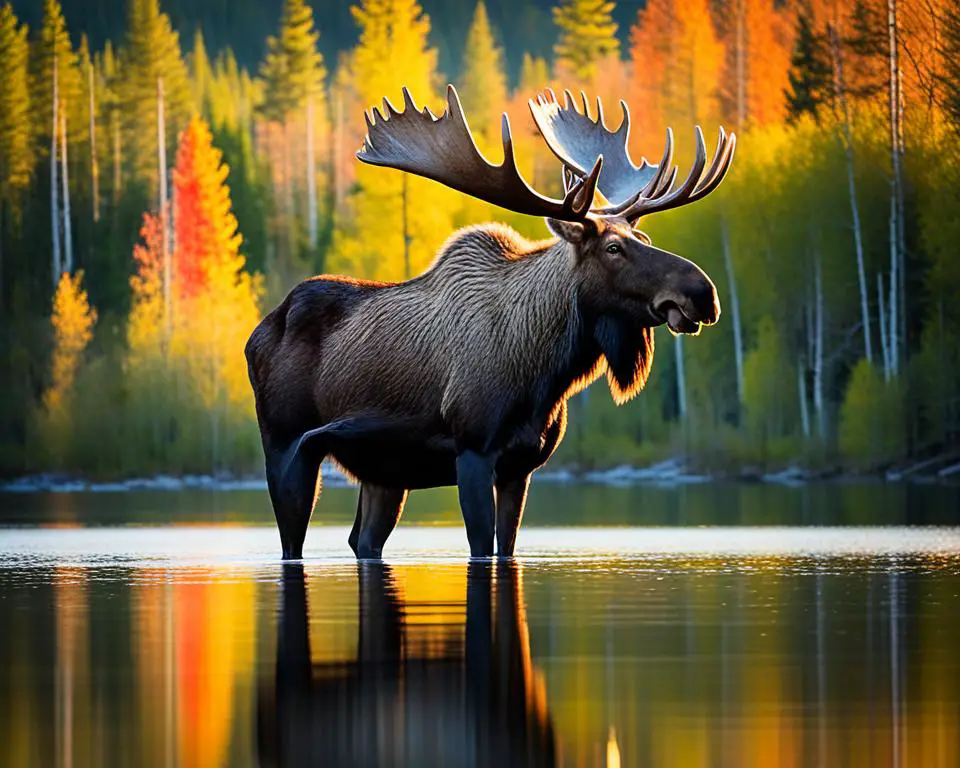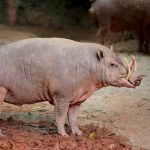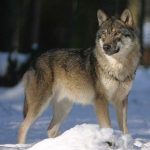Envision the vast wilderness of Ontario’s Sunset Country, a serene place where majestic creatures like the moose roam free amid the evergreen forests and quiet lakes. These gentle giants embody the essence of wildlife in North America, each one a testament to the incredible biodiversity our continent has to offer.
As we delve into the world of moose, we’ll share insights that extend beyond common moose facts. Whether you’re an avid wildlife enthusiast or simply seeking to broaden your wildlife knowledge, prepare to be intrigued by the unique characteristics that set these animals apart from their forest companions.
Your journey into the heart of moose country starts here, where every fact about these splendid animals is just as fascinating as the creatures themselves. Ready to learn more about the moose, its habits, and its habitat? Let’s explore the natural wonders these animals bring to our ecosystems.
Majestic Giants of the Forest
As you venture into the diverse ecosystems of North America, you’ll be greeted by the magnificent sight of the giant moose. These colossal residents of the forest wildlife tower over other members of the deer family with their imposing stature. Majestic and awe-inspiring, moose stand as towering emblems of the natural splendors awaiting in the verdant expanses of the continent.
The Impressive Size of Moose
Measuring between 5 to 6.5 feet at the shoulder and tipping the scales from 771 lbs for females to a staggering 881 lbs for males, these North American mammals are emblematic of the grandeur of the natural world. Remarkably, some of these giant moose can reach a monumental weight of 1,800 lbs, showcasing the spectacular scale of growth that can occur within the deer family.
Comparing Moose to Other Members of the Deer Family
When compared to their relatives in the deer family, moose are undeniably the behemoths of the group. The speed at which their young—one of nature’s most rapidly developing forest wildlife—can outpace a human in just a mere five days is a testament to their incredible growth capabilities and evolutionary prowess. Witnessing the grandeur of these creatures roaming free in their natural habitat is an enriching experience for any wildlife observer.
| Moose Characteristic | Female Measurements | Male Measurements | Young Calves Development |
|---|---|---|---|
| Weight | 771 lbs | 881 lbs (Up to 1,800 lbs) | Can outrun a human at 5 days old |
| Height at Shoulder | 5 to 6.5 feet | Fast growth rate | |
Your exploration of the forest’s wildlife would not be complete without acknowledging the towering presence of the moose—truly the giants among us in the diverse tapestry that is the deer family.
A Closer Look at Moose Antlers
As you observe the imposing figure of a bull moose against the verdant backdrop of North American forests, your eyes are inevitably drawn to its most distinguishing feature: the sprawling bull moose antlers. These magnificent structures are much more than mere ornaments; they are deeply rooted in the survival and social dynamics of moose populations. Let’s delve into the fascinating lifecycle of moose antlers and their role in wilderness ecosystems.
The Purpose of Moose Antlers Beyond Mating Season
While antler velvet wraps the moose’s antlers throughout the spring and summer months, providing the necessary nutrients for their growth, the spectacle does not end with the onset of fall. As the wildlife mating rituals commence, male moose, known as bulls, wield their expansive antlers in displays of dominance to assert their presence and intimidate rivals. Though the primary function of these antlers is for combat and courtship, they also symbolize the moose’s vitality and strength.
Annual Shedding of Antlers
Contrary to popular belief, the annual shedding of antlers in moose is a painless process that reconciles with the ebb and flow of the natural world. Commencing typically between mid-November and March, this shedding signifies the end of mating season and the conservation of energy during the colder months. Once shed, the cycle begins anew, with antlers reemerging in the spring, larger and more formidable than before, coating anew with velvety layers to protect and nourish the developing bone.
Understanding the importance of antlers in the life of a moose provides a window into the complex ecological roles these creatures play in North America’s forests. In your next wilderness adventure, you might just witness the regal sight of a bull moose foraging in the woods or crossing a misty meadow – a rare and treasured moment where you can appreciate the grandeur of nature’s artistry.
Understanding Moose Behavior and Habitat
When imagining the elusive moose, think of vast moose habitats dotted with snow, echoing the animal’s strong preference for colder climates. This isn’t simply a choice, but an essential cold climate adaptation engraved in the DNA of these serene animals. In environments with snowy winters, you can witness the distinctive animal behavior that enables these giants to thrive in the challenging conditions.
As temperate dwellers, moose struggle when temperatures exceed 80°F. This behavioral trait has them seeking out cool waters, be it a tranquil lake or a gentle river, offering you an unforgettable sight of them peering out from the watery depths—majestic, calm, and completely in their element.
The adaptability of moose is evident in how they traverse their habitat. You’ll notice their wide hooves, which work similarly to snowshoes, providing stability and ease as they move through snowy terrain and soft, marshy grounds. Observing a moose in its natural habitat, you’ll be captivated by the way it casually meanders—its gait both a symbol of adaptability and strength.
Through understanding moose behavior and their habitat, you gain a deeper appreciation for how these animals navigate the challenges posed by their environment—a mixture of instinct, evolution, and survival. Whether it’s the quiet presence of a moose in a snowy glade or the powerful stroke of one swimming against the current, these creatures continue to inspire wonder in the hearts of those lucky enough to witness them in the wild.
Moose Calves: Growth and Development
Did you know that within the realm of animal development, moose calves stand out for their remarkably swift growth rate? These little giants, born in the serene wilderness of the North American forests, embark on a journey of rapid wildlife growth that is essential for their survival.
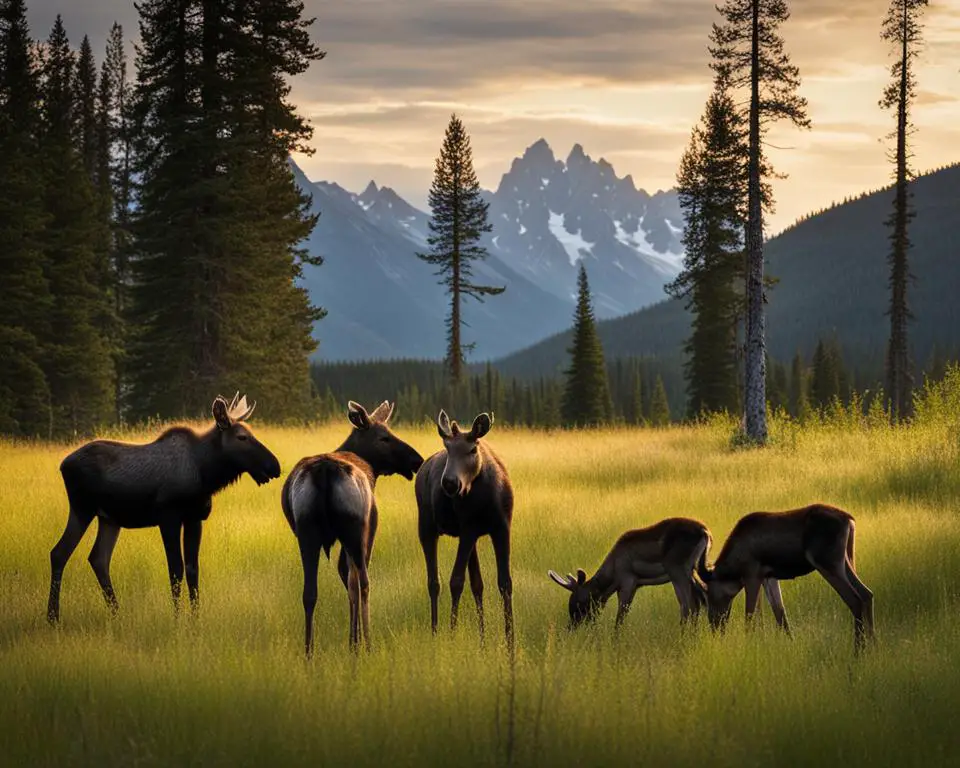
As spring blankets the forest with new life, moose calves are born into a world where size and strength are vital to evade the ever-present threat of predators. Within days of entering the world, these calves are already preparing to stand on their own hooves. Their growth trajectory is so impressive that by day five, they can outrun humans, an incredible feat that underscores the astonishing pace of their early animal development.
During the initial stages after birth, moose calves gain about one to two pounds daily. This weight gain is not just a matter of size; it’s a race to accumulate muscle and mass. By the time they are mature enough, these daily increments can sum up to a whopping five pounds, a clear indicator of their intensive wildlife growth process.
| Age of Calf | Daily Weight Gain | Growth Significance |
|---|---|---|
| Birth to 5 Days | 1-2 pounds | Initial development and mobility |
| 6 Days to Maturity | Up to 5 pounds | Increased survivability and self-sufficiency |
In observing these moose calves, you can’t help but marvel at the wonders of nature. Their evolution has finely tuned them to rise quickly from newborns to formidable young creatures of the woods. Embrace this insight into animal development and wildlife growth, and you’ll gain a deeper appreciation for the precious early lives of moose and the significance of their great start into the world.
The Solitary Life of a Moose
The vast expanses of North American forests serve as a backdrop for the moose, an animal renowned for its preference for solitude. Unlike many other species, these stately members of the deer family lead largely isolated lives, rarely engaging in social structures akin to herds. This solitary behavior is intrinsic to the moose’s existence, with the exception of the vibrant days of autumn when the forests bear witness to a shift in this pattern during the moose’s mating rituals.
Mating Season: The Exception to Their Solitude
In the fleeting time of mating season, the stillness of the moose’s solitary life is disrupted. Each fall, forests come alive with the sounds of bull moose in pursuit of companionship. During September and October, these solitary creatures temporarily forgo their usual habits for the sake of propagation. Bulls venture out to seek cows, engaging in mating rituals that are both fierce and fascinating. It is during this time that moose are most social, though their interaction is fleeting, purpose-driven, and as brief as the season itself.
Why Moose Prefer to Be Alone
Throughout the rest of the year, moose retreat into the solace of their individualistic existence. Their solitary behavior is more than an instinctual preference; it is an adaptation to the environment in which they thrive. Eschewing a complex social structure, moose are adapted to fend for themselves in the rugged North American wilderness. Exceptionally during spring, cow moose devote themselves to nurturing their young. Calves remain under their mother’s watchful eye, learning to navigate the world in preparation to take up the solitary mantle themselves at the arrival of the next mating season.
Your understanding of moose solitary behavior, their unique mating rituals, and the nuances of animal social structure in the wild is now deeper. The moose’s life is as mysterious and secluded as the forests they inhabit, with only the echoes of their autumn calls revealing their hidden ties to each other and the continuation of their legacy in the vast wilderness.
Moose: Herbivores of the Wilderness
If you’ve ever marveled at the sight of a moose, it’s not just their stature that’s impressive—it’s their diet too. As herbivorous mammals, moose play a critical role in the ecosystem, managing vegetation and affecting the landscapes they inhabit. Let’s forage into the details of the moose diet and their unique place in animal nutrition.
What Moose Eat to Maintain Their Size
The appetite of a moose is nothing short of enormous. To maintain their grand size, they consume an immense amount of flora. During the lush summer months, a moose’s daily diet includes around 73 pounds of vegetation—consisting of bark, shrubs, leaves, stems, and twigs. In winter, when the landscape is more barren, they still manage to ingest about 34 pounds of food each day. This hearty diet ensures that these impressive herbivorous mammals have the energy they need to thrive.
How Moose Digestion Works
The moose’s digestive system is uniquely adapted to process the cellulose-dense diet of the forest. With a complex, four-chambered stomach similar to that of cows, moose efficiently break down the fibrous material they consume. Here’s a simple table that illustrates the hierarchical process of the moose’s digestive system:
| Stomach Chamber | Function | Analogy in Cows |
|---|---|---|
| Rumen | Initial fermentation and breakdown of plant matter | The primary chamber for starting digestion |
| Reticulum | Filtration and regurgitation for cud chewing | Assists in cud formation for further breakdown |
| Omasum | Absorption of water and nutrients | The ‘filtering’ chamber in bovines |
| Abomasum | Final digestion with enzymes | Comparable to the human stomach |
As a champion of animal nutrition, the moose is a prime example of nature’s engineering. This remarkable digestion process allows these large creatures to extract all the necessary sustenance from their seemingly simple diet and stand as iconic figures in their forested domains.
Moose Adaptations for Survival
As you stand in awe of the moose’s size and stature, it’s easy to forget that their ability to thrive in the wild is a result of sophisticated animal adaptations and survival mechanisms. These magnificent creatures are outfitted by nature with features that enhance their wildlife resilience, allowing them to stand as icons of survival in the harsh climates of North America.
The moose’s thick, hollow hair is one such feature, an insulation marvel that keeps these animals warm during biting cold weather, and, like a life vest, aids in their buoyancy while they swim. On land or in water, this adaptation is a testament to their resilience in a variety of environments. Their grand antlers, while a symbol of autumn courtship rituals, double as formidable weapons against potential predators, showcasing the dual-purpose cleverness behind their design.
When it comes to the senses, moose may not have the sharpest eyesight, with their eyes set widely apart creating significant blind spots. However, this is expertly compensated for by an acute sense of smell and hearing, allowing them to detect threats and food sources efficiently. Their large ears can pinpoint the rustling of leaves or the subtle movements of other creatures with startling accuracy.
| Adaptation | Function | Illustration of Wildlife Resilience |
|---|---|---|
| Hollow Hair | Insulation & Buoyancy | Surviving extreme temperatures and aquatic environments |
| Antlers | Courtship & Defense | Attracting mates and deterring predators |
| Senses | Hearing & Smell | Compensating for limited vision to detect danger and food |
Understanding the animal adaptations of moose uncovers a deeper insight into nature’s wisdom. These survival mechanisms are not merely coincidental; they are the refined results of millennia of evolution, ensuring the continued presence of moose in the wild. Your respect for these beasts will grow as you recognize the array of natural tools at their disposal to conquer the challenges of their habitats.
Aquatic Abilities of Moose
When you think of moose, you might envision these stately creatures meandering through dense woodlands, but these giants are as comfortable in water as they are on land. Their ability to traverse aquatic landscapes is as fascinating as it is vital for their survival.
Moose Swimming Capabilities
One remarkable skill moose possess is moose swimming. These animals are not only built for navigating the forests but also for cutting through waters with surprising agility. In search of aquatic plants, moose can dive to depths of about 20 feet and remain submerged for approximately 30 seconds. The sight of a moose gliding through a river at speeds of up to six miles per hour can be both unexpected and awe-inspiring.
How Moose Use Water for Temperature Regulation
Alongside foraging, water serves an additional, crucial purpose for moose: body temperature control. During sweltering days, moose are known to wade into bodies of water to escape the heat. Immersing themselves in lakes and rivers, moose naturally modulate their body temperature, showcasing a sophisticated adaptation to their environment.
By understanding the aquatic abilities of moose, you expand your appreciation of these astounding animals, recognizing their nuanced interactions with the ecosystems they inhabit.
The Lingering Threats to Moose Populations
As stewards of nature, it’s crucial to address the challenges that moose populations face in the wild. While adult moose showcase resilience due to their formidable size, their young are not always as fortunate. Understanding the predator-prey dynamics is essential in crafting effective moose conservation strategies. Moreover, human encounters often present unforeseen hazards, impacting the delicate balance of wildlife protection.
Predators in the Wild
For moose calves, the first days of life are fraught with danger. Hidden among the verdant forests, predators such as wolves, bears, and cougars await the opportunity to prey on the vulnerable young. These natural but harrowing occurrences are a stark reminder of the harsh realities within predator-prey dynamics. It’s a cycle that underscores the need for wildlife protection measures that support both predator and prey species, safeguarding the ecological balance.
Human Encounters and Their Impact
Aside from natural threats, human activities pose a considerable risk to moose populations. Vehicle collisions remain a dire threat, often resulting in fatal consequences for these grand animals. Additionally, while hunting is a pastime anchored in tradition, it must be carefully regulated. In areas like Ontario, hunting is diligently monitored to mitigate overhunting risks, highlighting the importance of human responsibility in wildlife protection.
| Predator | Impact on Moose Calves |
|---|---|
| Wolves | Primary natural predator, often target the young or weakened adults |
| Bears | Known to prey on calves, especially in the spring and summer seasons |
| Cougars | While less common, they pose a threat to solitary moose calves |
Addressing these threats is fundamental to ensure that moose continue to be a symbol of the unspoiled wilderness. As you enjoy the beauty and serenity of these majestic creatures, remember the importance of supporting moose conservation efforts. Ensuring their survival is ensuring the future of our forests and their wondrous inhabitants.
The Moose Lifecycle: Birth to Maturity
The journey from birth to adulthood for the moose is a fascinating story of growth, survival, and independence. As large as they are, moose begin their lifecycle in the tender, vulnerable stages of calfhood. Born in the spring, these calves are the future of the forest, and their development is critical for the continuation of the species. Let’s delve into the stages of the moose lifecycle and uncover the milestones from animal reproduction to full-fledged wildlife development.
Within days of being born, moose calves are already poised to outpace predators—and even you, if you were to chase after them. This rapid growth is crucial, as the first year of life is filled with developmental leaps that prepare them for solitary survival in the wild. During this year, calves develop alongside their mothers, absorbing vital life skills until the approach of the next mating season signals their time to venture forth independently.
| Age | Development Milestone | Survival Skill Acquired |
|---|---|---|
| 0-5 Days | Rapid initial growth | Basic mobility to evade predators |
| 6 Months | Winter cold adaptation | Foraging for winter-appropriate food sources |
| 1 Year | Preparation for independence | Advanced environmental navigation and predator awareness |
If they manage to successfully dodge the threats posed by predators, moose can enjoy a lifespan ranging between 15 and 20 years, becoming iconic symbols of North America’s wildlife. Their animal reproduction rates and the nurturing of their offspring are fundamental to the health of moose populations, ensuring that these forest kings reign for generations to come.
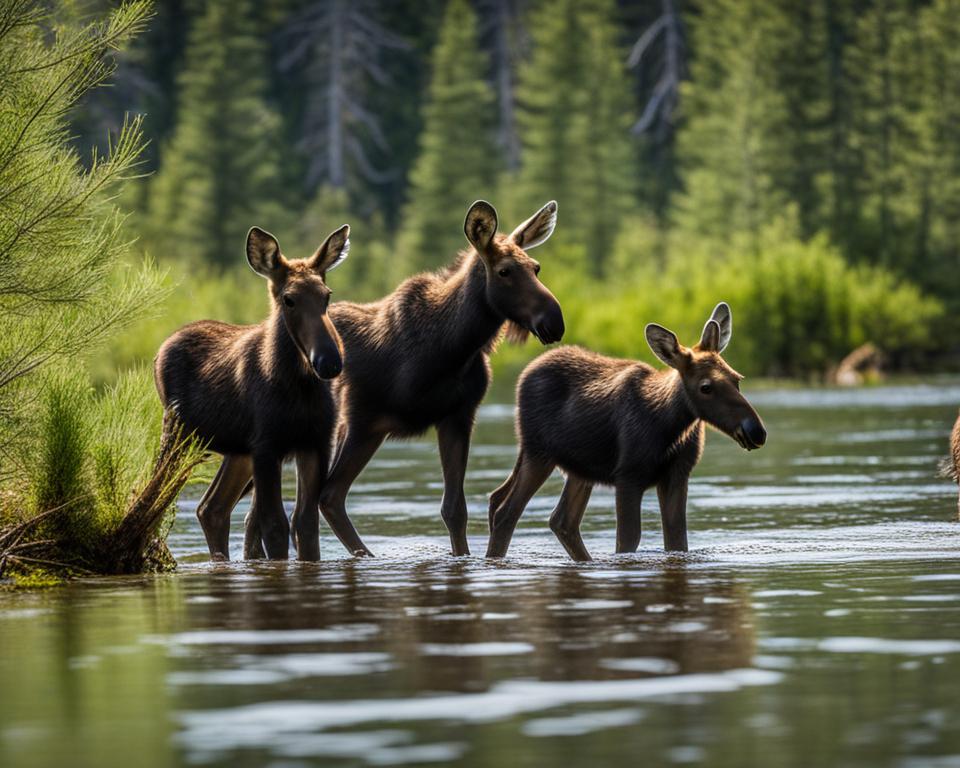
In the grand tapestry of North American wildlife, the growth of a moose from a tender calf to a resilient adult is a wondrous process that reflects the beauty and complexity of wildlife development. It’s a narrative that not only captivates us with its grace and strength but also underlines the need for continued conservation efforts to maintain the natural habitats where these magnificent creatures thrive.
Fun Facts About Moose: Unexpected Moose Trivia
Embark on a journey into the lesser-known realms of moose lore and discover the rich tapestry of moose symbolism and myths that have woven their way through various cultures over time. These fun facts and whimsical tales offer a glimpse into the cultural significance of these fascinating creatures within the wildlife narrative.
The Symbolic Meaning of Moose in Various Cultures
In the intricate web of nature’s storytelling, the moose’s presence has been imbued with profound moose symbolism across numerous cultures. The Algonquin tribes, native to the regions where moose roam, revered them as the “eater of twigs” – a name deriving directly from their forested diet but also perhaps alluding to their ability to persist through the harsh realities of their environment.
Exploring Moose-Related Myths and Legends
As we delve into the shadowy forest of folklore, stories abound of the moose’s grandeur and mystique playing pivotal roles. From the legends of the indigenous peoples to the tall tales of frontier life, the moose has been a character symbolizing both strength and the untamed essence of the wilderness. Herein lies the foundation for an array of wildlife lore that continues to captivate the imagination.
Did you know? In North American lore, moose are sometimes whimsically dubbed as “rubber-nosed swamp donkeys,” a testament to their unique appearance and adaptations to wetland environments.
A notable feature often shrouded in curious fascination is the ‘bell’ – the flap of skin that dangles beneath the moose’s chin, a distinctive trait often overlooked in common knowledge yet steeped in the allure of woodland fables. The ‘bell’ itself serves as an emblematic feature that further enhances the cultural significance of this noble animal.
| Cultural Interpretation | Symbolic Significance |
|---|---|
| Algonquin Tradition | Resilience and Sustenance (“eater of twigs”) |
| Folklore Symbol | Strength and Untamed Nature |
| Common Epithets | Whimsy and Adaptability (“rubber-nosed swamp donkeys”) |
With every sighting of a moose in the wild or mention of it in cultural texts, we are reminded of the indelible mark that these creatures have left on the collective human psyche. Their depiction in wildlife tales is not only entertaining but also underscores the essence of living in harmony with the natural world that surrounds us.
Conservation Efforts for Moose
Imagine embarking upon a tranquil hike through the woods; the rustle of leaves and the call of distant birds accompany you. Then, suddenly, the serene landscape reveals its most majestic inhabitant: the moose. This moment of awe is a gentle reminder of why wildlife conservation, especially efforts focused on endangered species and habitat protection, is vital. Such endeavors ensure that future generations may also experience these encounters with one of North America’s most impressive wildlife species.
Your connection with nature cultivates a passion for wildlife and a sense of responsibility for the beings that share our world. Moose, as significant as they are, face numerous challenges; but through concerted conservation efforts, their survival is not merely a hope but a goal within our grasp. By protecting their habitats, we ensure moose have the space to thrive, free from the encroachments of urban development and industrialization.
Regulating hunting practices is another cornerstone in the pursuit of moose conservation. By setting and enforcing sustainable hunting limits, we balance the tradition of hunting with the necessity of preserving moose populations. This balance is delicate and requires ongoing attention and adaptation to the ever-changing dynamics of wildlife populations and human activity.
Moose frequently cross paths with human territories, resulting in dangerous encounters with vehicles. Mitigating these human-wildlife conflicts is a complex task, requiring collaboration between wildlife biologists, town planners, and you, the concerned citizen. Initiatives such as wildlife crossings and driver awareness campaigns are examples of proactive measures that can diminish the risks these gentle giants face each day.
| Conservation Measure | Objective | Impact on Moose Populations |
|---|---|---|
| Habitat Protection | Maintain ecosystems necessary for moose survival | Preserves natural living conditions, promoting health and growth |
| Regulated Hunting | Ensure sustainable moose population levels | Prevents overhunting, allowing populations to replenish |
| Human-Wildlife Conflict Management | Reduce moose fatalities due to vehicular collisions | Decreases unnatural death rates, improving population stability |
As you note the significance of these initiatives, remember that conservation is a collective effort. Your involvement in community discussions, support for nature preserves, and adherence to wildlife-friendly practices can make all the difference. By ensuring these conservation efforts are successful, you play an active role in safeguarding the presence of moose in our forests, symbolizing our commitment to the larger ecosystem where both humans and wildlife can flourish.
Moose in Pop Culture and Media
Imagine the intricate tapestry of American culture, interwoven with symbols and representations of the wild. Amidst this cultural fabric, the moose has emerged as an iconic wildlife emblem, often standing tall as the quintessential representation of the wilderness and the great outdoors. You’ve likely encountered this majestic creature beyond the realm of forests and mountains; they have stamped their hooves across various forms of entertainment, asserting their presence as a beloved animal representation.
When you flip through the channels or browse streaming platforms, it’s not uncommon to see the moose’s distinct form gracing your screen. From animated films that personify these gentle giants with warmth and humor to television shows that feature them as characters evoking the warm fuzzy nostalgia of the American wilderness experience, the moose in media is a gentle giant that has captured the hearts of audiences. Their subtle allure lies in their ability to remind us of nature’s splendor, even when we’re cozied up indoors.
Moreover, the moose has been adopted as an endearing mascot by various environmental and outdoor recreational brands, further cementing their status in pop culture. Each appearance in commercials or logos serves as a nudge to the collective American spirit, calling to mind the country’s sprawling national parks and the call of the wild that still beats in the heart of the nation. With every depiction, whether on a t-shirt or in an advertisement, the moose continues to stand as a timeless mascot harmonizing with our deep-seated reverence for nature.

